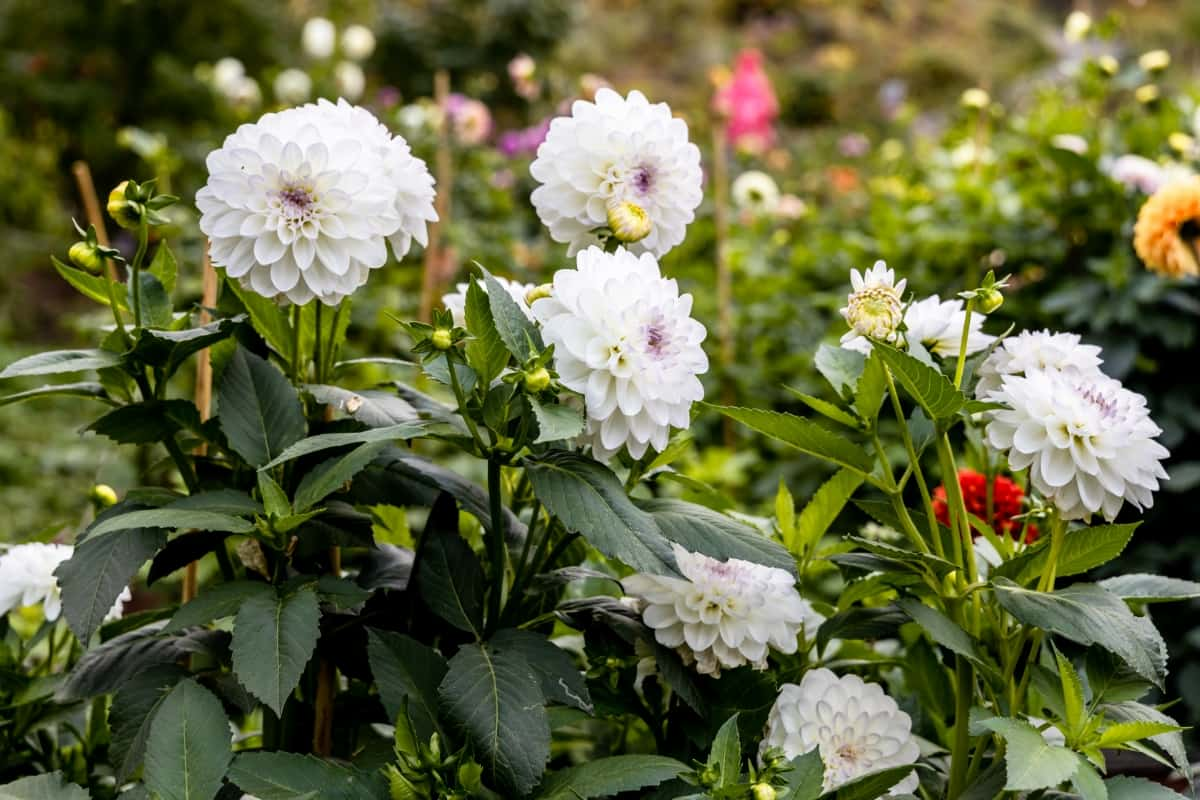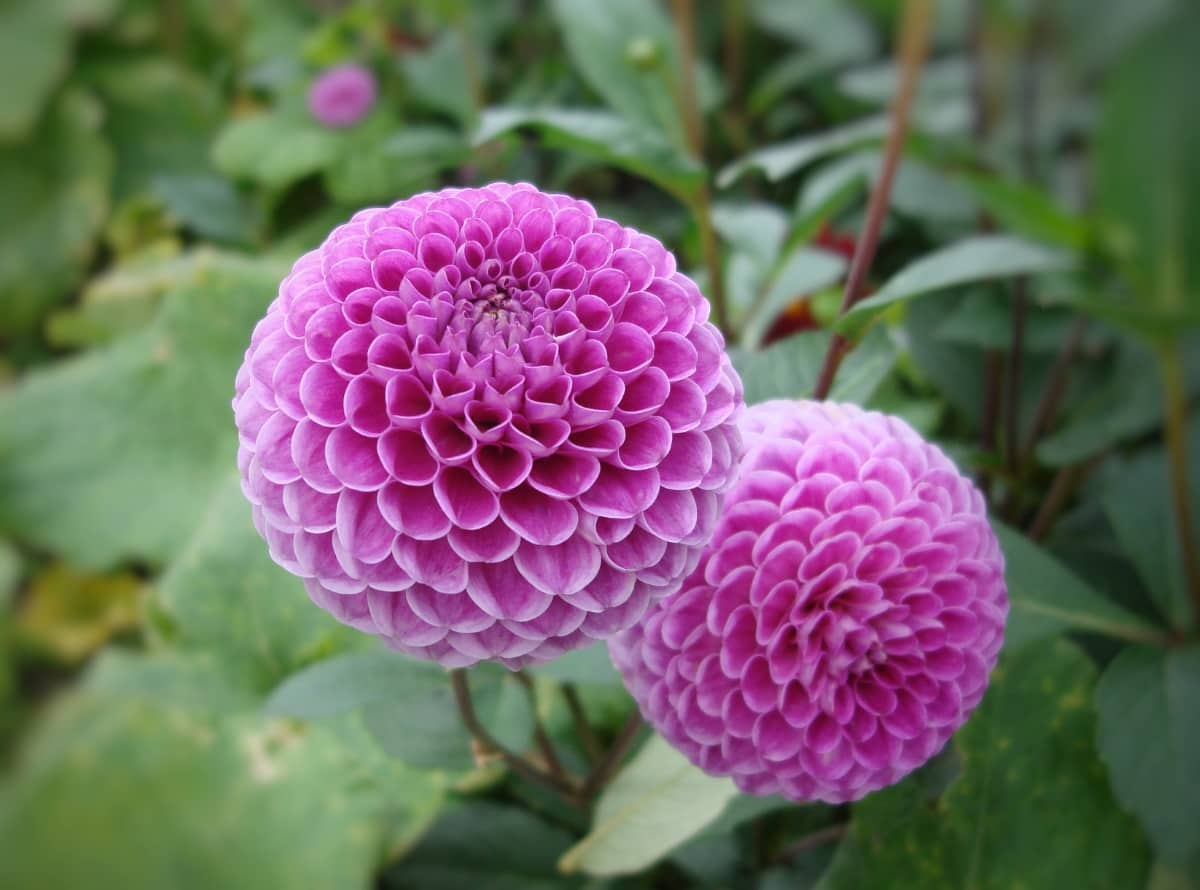Flowers such as dahlias are beautiful and come in various colors and shapes. It is relatively easy to grow them and take care of them, which makes them a popular choice among gardeners. Here are some tips on how to plant, grow, and care for dahlia:

How to Grow and Care for Dahlias
Best Soil and Fertilizer for Dahlia Plants
Dahlia plants grow best in soil that drains well and has a pH between 6.5 and 7.5. The soil should be loose and sandy to allow for proper drainage. Adding organic matter such as vermicompost or well-rotten manure to the soil is also important to provide the nutrients dahlia plants need to grow.
A low-nitrogen fertilizer is your best bet to promote healthy growth and abundant dahlia blooms. Use a balanced fertilizer with a ratio of 5-10-10 or 10-20-20. You can also use processed cow manure, a rich nutrient source for dahlias. It’s important to note that dahlias require a low-nitrogen fertilizer. For best results, apply the fertilizer every 4-6 weeks during the growing season and water the plants regularly to ensure proper nutrient absorption.
Proper Watering Techniques for Dahlias
- During the growing season, they need about 1-2 inches of water weekly from rainfall or irrigation. It’s important to water deeply so the water reaches the roots.
- Water the dahlias at the base of the plant, not from above. Use a watering can or a hose with a gentle spray nozzle to avoid disrupting the soil around the plant.
- Water dahlias early in the morning or late in the evening. This helps to prevent the water from evaporating too quickly. It also allows the foliage to dry before nightfall, reducing disease risk.
Sunlight Requirements for Healthy Dahlia Growth
Dahlias require full sun to grow and bloom properly. This means they need 6 to 8 hours a day of direct sunlight per day. If dahlias do not receive enough sun, they may produce fewer flowers, or the blooms may be smaller. When planting dahlias, choose a location that receives full sun for most of the day. This means finding a spot not obstructed by trees or other tall plants that may cast shadows.
How to Plant Dahlia Bulbs in Containers
- Select a container at least 12 inches deep and 12 inches wide. Make sure the container has good drainage holes.
- Fill the container with a good-quality potting mix. Make sure the potting mix is moist but not too wet.
- Make a hole in the potting soil about 4 inches deep.
- Place the dahlia bulb in the hole with the pointed end facing up. Cover the bulb with potting mix and gently press down.
- Water the container thoroughly.
- Place the container in a sunny location. Dahlias require at least 6 hours of sunlight per day.
- Water the container regularly, keeping the potting mix moist but not too wet.
Growing Dahlias from Seed: Step-By-Step Guide
- Start by selecting a seed tray or a small pot with holes to drain at the bottom. Fill the container with a good quality seed-starting soil mix.
- Moisten the soil mix and sprinkle the dahlia seeds on top of the soil, spacing them about an inch apart.
- Press the seeds into the soil, but not bury them too deep. Dahlias need light to germinate, so keep the seeds on the soil’s surface.
- Cover the container with a lid made of plastic or a clear plastic bag, which helps to retain moisture and warmth.
- Move the container to a warm and bright location, such as a windowsill or under grow lights. Keep the soil moist but not waterlogged.
- After about 10-14 days, the dahlia seeds should germinate. Transplant them into individual pots once the seedlings have two sets of leaves.
- When the seedlings are about 6-8 inches tall, you can transplant them outdoors in a sunny location with well-draining soil. Space the plants about 12-18 inches apart.
- Water the dahlias regularly, but do not overwater. Fertilize your Dahlias with a balanced fertilizer every two weeks to encourage healthy growth and blooms.
- As the dahlias grow taller, you may need to provide support with stakes or cages to prevent them from bending or breaking.
In case you missed it: How to Plant and Care for Chrysanthemums: Outdoor Growing Instructions

Protecting Dahlias from Pests and Diseases
- When purchasing dahlias, make sure to choose plants that are free from any signs of diseases or pests. Look for healthy plants with green leaves and no visible signs of insect damage.
- Regularly remove any dead plant material or debris from around the dahlia plants. This will help to reduce the chances of pests and diseases spreading.
- Overwatering can lead to fungal diseases, so water dahlias only when necessary. Water the plants at the base, and avoid getting water on the leaves.
- Chemical pesticides can harm beneficial insects and pollinators, so it’s best to use organic pest control methods. Some options include neem oil, insecticidal soap, and diatomaceous earth.
- Monitor your dahlias for signs of pests or diseases, such as yellowing leaves, spots, or wilting. If you find any issues, take action immediately to prevent the problem from spreading.
Pruning and Staking Dahlias for Optimal Growth
- To prune dahlias, cut the stem just above a set of leaves or a bud. It stimulates the plant to produce more flowers. Be sure to use clean and sharp pruning shears to avoid damaging the plant.
- Staking dahlias is also important to prevent the tall stems from falling over and breaking. It also helps to keep the plant upright and stable during windy conditions.
- To stake dahlias, use bamboo stakes or metal rods and insert them into the soil near the base of the plant. Then, tie the plant’s stems to the stake with a soft material like garden twine or stretchy plant ties. Don’t tie the stems too tightly, which can damage the plant.
Overwintering Dahlias: Preparing for Colder Months
- As the growing season ends, gradually reduce the water you give your dahlias. This will help the plant go into dormancy and prepare for winter.
- Once the first frost hits, cut back the foliage of your dahlia plant to about 6 inches; this will help the plant conserve its energy during the winter.
- Once the foliage has been cut back, it is time to dig up the tubers. Use a garden fork to lift the tubers out of the soil gently. Be careful not to damage them.
- Remove any excess soil and debris once the tubers have been dug up. Allow the tubers to dry in a dry and warm location, such as a garage or basement.
- Once the tubers are dry, place them in peat moss, sawdust, or vermiculite container. Check on the tubers periodically throughout the winter to ensure they are still dry and in good condition.
Dividing and Propagating Dahlias for More Plants
- To begin, carefully dig up the dahlia tubers from the ground. Use a shovel to loosen the soil around the Dahlias and gently lift the tubers.
- Next, separate the tubers by carefully pulling them apart. Each tuber should have at least one eye or bud. If the tuber has no eye, it will not grow into a new plant.
- A tuber with multiple eyes or buds can be cut into pieces to create multiple plants. Use a clean, sharp knife to cut the tuber into sections, ensuring each section has at least one eye or bud.
- Allow the tubers to dry for a couple of days before planting them. This will help prevent rot and disease.
- You can plant the tubers in the ground or containers when they have dried. Choose a sunny spot with well-draining soil. Plant the Dahlia tubers 4 to 6 inches deep and 12 to 18 inches apart.
- Water the newly planted tubers thoroughly and add a balanced fertilizer to the soil. Continue to water the plants regularly, especially during dry spells.
Harvesting Dahlias for Bouquets and Arrangements
- Dahlias should be harvested when the blooms are fully open but before they start to decline. This is usually around mid-morning when the dew has dried.
- Use sharp and clean pruning shears to avoid damaging the stem.
- Cut the stem at an angle just above the second set of leaves on the stem. It promotes the plant to produce more blooms.
- Immediately after cutting, place the stems in a bucket of water. It stops air bubbles from forming in the stem, which can cause wilting.
- Regularly harvest dahlias throughout the growing season to encourage the plant to produce more blooms.
In case you missed it: How to Grow and Care for Columbine Flowers: Planting Instructions

Conclusion
By following these easy steps, you can plant, grow, and care for dahlias and enjoy their beautiful blooms year after year.
- Feed Your Flock for Less: Top 10 Tips to Save on Chicken Feed
- Ultimate Guide to Ossabaw Island Hog: Breeding, Raising, Diet, and Care
- Hatching Answers: The Top 10 Reasons Your Chickens Aren’t Laying Eggs
- Eggs and Economics: Breaking Down the Cost of Raising Backyard Chickens
- Defend Your Greens: Proven Methods to Keep Iguanas Out of Your Garden
- Ultimate Guide to Cinnamon Queen Chicken: A Comprehensive Guide for Beginners
- Ultimate Guide to California Tan Chicken: Breeding, Raising, Diet, Egg-Production and Care
- Ultimate Guide to Marsh Daisy Chicken: Breeding, Raising, Diet, and Care
- 10 Types of Chicken Farming Businesses You Can Start for Profits